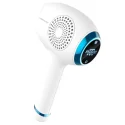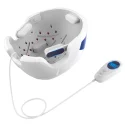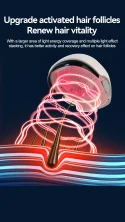2023-06-06
Female hair loss is a common but disturbing problem that can negatively affect a woman's appearance and self-confidence. However, with advances in medicine and science, there are now a variety of treatments available to help women regain healthy looking hair. In this article, we'll explore some of the options that are considered the best treatments for hair loss in women.

1. Drug treatment:
Medication for hair loss in women is a common way to help promote hair growth and slow down the hair loss process. However, you should follow your doctor's advice when using medications and be aware of possible side effects and methods of use. Here are some commonly used drug treatment options for hair loss in women:
Minoxidil: Minoxidil is a topical medication that stimulates hair growth. It promotes blood circulation to the hair follicles and dilates capillaries, thereby increasing the supply of nutrients and oxygen. Minoxidil is the only drug approved by the U.S. Food and Drug Administration (FDA) for hair loss in women. It is usually available in a concentration of 2% or 5%, applied to the affected scalp twice a day. Note, however, that using minoxidil requires continued use to maintain results, and it may take several months to see noticeable improvement.
Oral contraceptives: Certain oral contraceptives may also be used to treat hair loss in women, particularly androgen-related hair loss. These oral contraceptives contain estrogen and progestin, which can help balance hormone levels and reduce hair loss due to excess androgen. However, the use of oral contraceptives should be under the supervision of a doctor, and it may take several months to see results.
Antiandrogens: In some cases, antiandrogens such as montelukast (Spironolactone) or spironolactone (Cyproterone acetate) may be used to treat female pattern baldness. These drugs inhibit the effects of androgens, thereby slowing down the hair loss process. However, the use of these drugs requires the supervision of a doctor, and the side effects and precautions should be carefully understood before use.
Hormone replacement therapy: For some women, hormone imbalances can lead to hair loss problems. In this case, your doctor may recommend hormone replacement therapy to help restore hormone balance. This may include the use of estrogen or other hormonal supplements, but must be done under the supervision of a doctor and requires regular monitoring.
Remember, when using any medication, it is best to do it under the guidance of a doctor. They can assess your condition and give you individualized treatment recommendations. Also, different drugs work differently in individuals, so results will vary from person to person. Continuing with your treatment is often the key to getting the best results.
2. Nutrition conditioning
Nutritional conditioning for female hair loss is important to promote healthy hair and slow down the hair loss process. Here are some nutritional conditioning suggestions that can help with hair loss in women:
Protein intake: Ensuring adequate protein intake is key to maintaining healthy hair. Protein is the main building block of hair and a lack of protein can lead to brittle and brittle hair. Protein-rich foods include lean meats, fish, poultry, beans, nuts, and dairy products.
Iron and Zinc Intake: Iron and zinc are essential minerals for maintaining healthy hair. Iron deficiency may lead to anemia, while zinc deficiency may cause hair brittleness and loss. Make sure to eat foods rich in iron and zinc, such as green leafy vegetables, lean meats, legumes, nuts and whole grains.
Vitamin intake: Vitamins are essential for hair growth and health. In particular the following vitamins play an important role in female hair loss:
Vitamin A: Helps balance scalp oil. Food sources include carrots, squash, spinach, and more.
Vitamin C: Contributes to the synthesis of collagen, maintaining the elasticity and health of hair. Food sources include citrus fruits, strawberries, tomatoes, etc.
Vitamin E: Antioxidant, promotes hair growth. Food sources include nuts, seeds, vegetable oils, and more.
Vitamin D: Linked to hair growth and health. Food sources are limited but can be obtained through sun exposure and supplements.
Vitamin B complex: Vitamin B complex is very important for promoting hair growth and preventing hair loss. Food sources include whole grains, poultry, fish, legumes, and more.
Omega-3 fatty acid intake: Omega-3 fatty acids are essential for hair health, reducing scalp inflammation and nourishing hair. Consume foods rich in Omega-3 fatty acids, such as fish (salmon, cod), flaxseed, sesame, etc.
Avoid malnutrition and extreme diets: Malnutrition and extreme diets can lead to nutrient deficiencies that can affect hair health and growth. Maintaining a balanced diet that includes a variety of food sources will help provide the vitamins, minerals, and nutrients your hair needs.
In addition to adjusting your diet and supplementing nutrients, you should also pay attention to maintaining proper water intake, regular exercise and reducing stress. Also, if you think you may be malnourished or have a specific cause of your hair loss, consult a professional physician or nutritionist for individualized advice and a treatment plan.
3. Low-intensity laser therapy
Low-Level Laser Therapy (LLLT) is a non-invasive treatment that is used to help improve hair loss in women. This treatment uses low-energy laser or LED light to illuminate the scalp to stimulate the growth and repair of hair follicles.
Principle: Low-intensity laser irradiation can increase the blood circulation of the scalp and improve the oxygen and nutrient supply to the hair follicles. It also stimulates energy production in cells, promotes a longer hair growth cycle, and inhibits hair follicle shrinkage.
How it's used: Low-level laser treatments are often done with portable devices, such as laser helmets, laser combs, or laser hair ties. These devices irradiate the scalp at designated times, usually several times a week for a few minutes at a time.
Results and duration: The results of low-level laser treatment vary from person to person, and different people may require different treatment cycles to see noticeable improvements. In general, it takes several months or even longer to see significant results. During the course of the treatment, an improvement in hair quality, a reduction in hair thinning, and an increase in hair growth rate can be expected.
Safety: Low-level laser therapy is generally considered safe and does not cause significant side effects or pain. However, a medical professional should be consulted prior to use to understand the best treatment plan for individual circumstances. During use, follow the device's instructions for use and your doctor's advice.
It's important to note that low-level laser therapy may not work for everyone, especially if there are certain medical conditions or other limitations. Therefore, it is recommended to consult a professional doctor before undergoing treatment to determine whether it is suitable for your situation.
Debunking Myths and Revealing Truths: The Efficacy of Laser Helmets for Hair Loss










